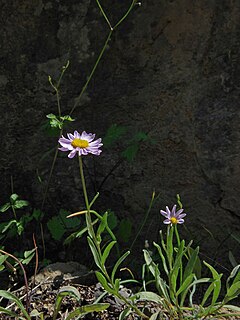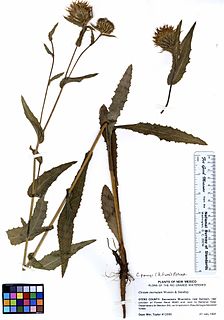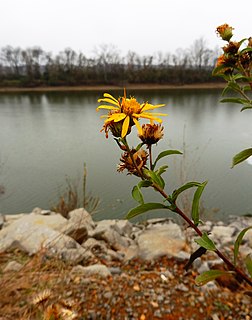
Heterotheca, are North American plants in the sunflower family.

Heterotheca grandiflora is a species of flowering plant in the daisy family known by the common name silk-grass goldenaster or telegraphweed. It is native to the southwestern United States and northwestern Mexico, but it can be found in other areas as an introduced species, such as Hawaii. It is often a roadside weed even where it is native.
Heterotheca oregona is a species of flowering plant in the daisy family known by the common name Oregon false goldenaster. It is native to the west coast of Canada and the United States in British Columbia, Washington, Oregon, and California as far south as Los Angeles County.

Heterotheca sessiliflora is a species of flowering plant in the daisy family known by the common name sessileflower false goldenaster. It is native to California, Sonora, and Baja California.
Erigeron aequifolius is a rare species of flowering plant in the aster family known by the common names Hall's daisy and Hall's fleabane.
Eriophyllum ambiguum is a species of flowering plant in the aster family known by the common name beautiful woolly sunflower. It is native to the deserts and adjacent hills of southern and eastern California, northwestern Arizona, and southern Nevada.

Pyrrocoma lanceolata is a species of flowering plant in the aster family known by the common name lanceleaf goldenweed. It is native to western North America from central Canada to northeastern California to Colorado, where it grows in many types of habitat, including disturbed places and areas with wet, alkali soils. It is a widespread and variable plant. It is a perennial herb growing one or more stems up to about half a meter long. The stems are decumbent or upright, reddish, usually somewhat hairy to quite woolly, and glandular toward the ends of the stems. The largest leaves are at the base of the plant, each measuring up to 30 centimeters in maximum length. They are generally lance-shaped with sawtoothed edges. The inflorescence bears several, up to 50, flower heads lined with reddish to green phyllaries. Each contains yellow disc florets and ray florets. The fruit is an achene up to a centimeter long including its pappus.

Packera breweri is a species of flowering plant in the aster family known by the common name Brewer's ragwort. It is endemic to central California, where it occurs in the woodlands and grasslands of the Central Coast Ranges. They are more frequently found in mid-southern counties of California near the coast, such as Kern or Monterey.
Packera macounii is a species of flowering plant in the aster family known by the common name Siskiyou Mountains ragwort. It is native to the west coast of North America from British Columbia to far northern California, where it grows in chaparral and mountain forests, often on serpentine soils.

Wyethia angustifolia is a species of flowering plant in the aster family known by the common names California compassplant and narrowleaf mule's ears. It is native to the west coast of the United States from Washington to California, where it grows in grassland, meadows, and other open habitat. It is a perennial herb growing from a tough taproot and caudex unit and producing a stem 30 to 90 centimeters tall. The leaves have lance-shaped blades up to 50 centimeters tall. The inflorescence produces one or more large sunflower-like flower heads at the top of the hairy stem. The head has narrow, hairy phyllaries at the base. It contains up to 21 yellow ray florets each up to 4.5 centimeters long and many yellow disc florets. The fruit is an achene which may be nearly 2 centimeters long including its pappus.

Wyethia glabra is a species of flowering plant in the aster family known by the common name Coast Range mule's ears. It is endemic to California, where it grows in the North and Central Coast Ranges. It is a perennial herb growing from a tough taproot and caudex unit and producing a stem up to 40 centimeters tall. It is hairless to hairy and glandular. The leaves have lance-shaped or oval blades up to 45 centimeters long. The inflorescence is usually a solitary flower head or occasionally a cluster of 2 or more. The head has lance-shaped leaflike phyllaries at the base. It contains up to 21 yellow ray florets each up to 5 centimeters long and many yellow disc florets. The fruit is an achene over a centimeter long, including its pappus.

Erigeron maniopotamicus is a rare species of flowering plant in the aster family known by the common name Mad River fleabane. It is endemic to northwestern California, where it is known from only four locations in Humboldt and Trinity Counties.
Heterotheca monarchensis is a rare species of flowering plant in the aster family known by the common names monarch goldenaster and sequoia false goldenaster. It is endemic to Fresno County, California, where it is known from only one location near Boyden Cave in the Kings River Canyon. It grows in the limestone cliffs of this Sierra Nevada river canyon, along with a few other rare local endemics. The plant was discovered in July, 1995, and described to science as a new species in 1996.
Ericameria gilmanii is a rare North American species of flowering plants in the aster family known by the common names Gilman's ericameria, Gilman's goldenbush, Gilman goldenweed, and whiteflower goldenbush. It is endemic to California, where it has been found in and east of the southern Sierra Nevada, in Inyo County and on Owens Peak in northeastern Kern County. It is a poorly known plant. There are six known populations, but only one has been observed in the last 20 years.

Cirsium parryi, or Parry's thistle, is a species of North American flowering plants in the aster family. It is native to the southwestern United States, where it has been found in Colorado, Arizona, and New Mexico.
Erigeron piscaticus is a rare species of flowering plant in the aster family known by the common name Fish Creek fleabane. It is endemic to Arizona in the United States, where it is known from three locations in Maricopa and Graham Counties.
Solidago verna is a species of flowering plant in the aster family known by the common names springflowering goldenrod and spring goldenrod. It is native to North Carolina and South Carolina in the United States.
Chrysopsis linearifolia, is a North American species of flowering plant in the aster family. It has been found only in Florida.

Heterotheca subaxillaris, camphorweed, is a North American species of flowering plant in the aster family. It is widespread across much of the United States as well as Mexico and Belize.

Heterotheca camporum, lemonyellow false goldenaster, is a North American species of flowering plant in the aster family. It is found only in the central United States, primarily the Ozarks, the Cumberland Plateau, and the middle Mississippi Valley. There are reports of additional populations in the Northeast, the Southeast, and in the Great Lakes region, but these appear to be waifs or naturalizations.












